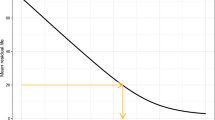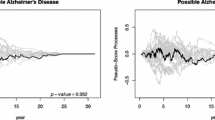Abstract
It is important that the process of studying and modelling the prognosis of disability should be conducted using time-to-event data, as the dynamic nature of disability could cause intervention on the modifiable (prognostic) factors, thus changing the course to a more favourable outcome. In disability research, the Cox PH model is frequently used to identify prognostic factors for the life expectancy of people with disabilities and to evaluate the treatment effects on the time to event. Accurate detection of influential observations is an important factor when fitting the Cox PH model, as influential observations in the Cox PH model can cause model misspecification, inaccurately determined factors, missed valuable biological information and/or violation of the proportional hazard assumption. In this paper, a novel multiple case detection method for influential observations is recommended in the Cox model. The aim of the paper is to inform clinicians and researchers who use the Cox PH model for describing the survival time as a function of multiple prognostic factors, regarding the importance of the detection of influential observations that can lead to misleading conclusions if they are present in the data set. The efficiency of the proposed method is presented through the real dataset. Additionally, in the specific case of North Cyprus, the aim is emphasize the importance of survival modelling studies that determine the prognostic factors affecting the lives of people with disabilities, to improve life quality and to develop a plan for healthier and higher quality life styles programmes for people with disabilities. As a first step, it is recommended that a system of database records of disabilities should be established and maintained by the government to raise public awareness.

Similar content being viewed by others
References
Anasetti, C.: What are the most important donor and recipient factors affecting the outcome of related and unrelated allogeneic transplantation? Best Pract. Res. Clin. Haematol. 21, 691–697 (2008)
Barlow, W.E., Prentice, R.L.: Residuals for relative risk regression. Biometrika 75, 65–74 (1988)
Bednarski, T.: On sensitivity of Cox’s estimator. Stat. Decis. 7, 215–228 (1989)
Bednarski, T.: Robust estimation in Cox regression model. Scand. J. Stat. 20, 213–225 (1993)
Cook, R.D.: Assessment of local influence. J. Roy. Stat. Soc.: Ser. B (Methodol.) 48, 133–169 (1986)
Cornelissen, J., Nakamura, R., Boeckh, M., Gratama, J., Brooimans, R., Zaia, J., Forman, S., Gaal, K., Gasior, G., Sullivan, L., Boyce, C., Soutwick, P.: A prospective multicentre clinical trial evaluating itag Mhc tetramers for prediction of recurrent or persistent cytomegalovirus infection in allogeneic stem cell transplant recipients. Bone Marrow Transplant. 37, 30–31 (2006)
Cox, D.R., Snell, E.J.: A general definition of residuals. J. R. Stat. Soc. 30, 248–275 (1968)
Cox, D.R.: Regression models and life tables (with discussion). J. R. Stat. Soc. B 34, 187–220 (1972)
Fries, J.M., Singh, G., Morfeld, D., Hubert, H.B., Lane, N.E., Brown, B.W.: Running and the development of disability with age. Ann. Intern. Med. 121, 502–509 (1994)
Glover, G., Ayub, M.: How people with learning disabilities die. Learn. Disabil. Obs. (2010)
Gönen, M., Heller, G.: Concordance probability and discriminatory power in proportional hazards regression. Biometrika 92, 965–970 (2005)
Harrell, F.E.: Regression modeling strategies: with applications to linear models, logistic regression, and survival analysis. Springer, Berlin (2001)
Hirvikoski, T., Mittendorfer-Rutz, E., Boman, M., Larsson, H., Lichtenstein, P., Bölte, S.: Premature mortality in autism spectrum disorder. Br. J. Psychiatry 208, 232–238 (2016)
Hutton, J.L., Colver, A.F., Mackie, P.C.: Effect of severity of disability on survival in north east England cerebral palsy cohort. Arch. Dis. Child. 83, 468–474 (2000)
Janicki, P.M., Dalton, A.J., Michael Henderson, C., Davidson, P.W.: Mortality and morbidity among older adults with intellectual disability: health services considerations. Disabil. Rehabil. 21, 284–294 (1999)
Kennedy, J., Eberhart, R. C.: A discrete binary version of the particle swarm algorithm. In: Proceedings of IEEE international Conference on Computational Cybernetics and Simulation, pp. 4104–4108 (1997)
Kennedy, J., Eberhart, R.: Particle swarm optimization. In: Proceedings of IEEE International Conference on Neural Networks, 1942–1948 (1995)
Klein, J.P., Moeschberger, M.L.: Survival analysis: techniques for censored and truncated data. Springer Science & Business Media, Berlin (2005)
Kleinbaum, D.G., Klein, M.: Survival analysis, vol. 3. Springer, New York (2010)
Leveille, S.G., Penninx, B.W., Melzer, D., Izmirlian, G., Guralnik, J.M.: Sex differences in the prevalence of mobility disability in old age: the dynamics of incidence, recovery, and mortality. J. Gerontol. B Psychol. Sci. Soc. Sci. 55, 41–50 (2000)
Majer, I.M., Nusselder, W.J., Mackenbach, J.P., Klijs, B., van Baal, P.H.: Mortality risk associated with disability: a population-based record linkage study. Am. J. Public Health 101, 9–15 (2011)
Manton, K.G., Corder, L.S., Stallard, E.: Estimates of change in chronic disability and institutional incidence and prevalence rates in the US elderly population from the 1982, 1984, and 1989 National Long Term Care Survey. J. Gerontol. 48, 153–166 (1993)
Mehta, N.K., Patel, S.A., Ali, M.K., Narayan, K.V.: Preventing disability: the influence of modifiable risk factors on state and national disability prevalence. Health Aff. 36, 626–635 (2017)
Mikaeloff, Y., Suissa, S., Vallée, L., Lubetzki, C., Ponsot, G., Confavreux, C., Tardieu, M.: KIDMUS study group: first episode of acute CNS inflammatory demyelination in childhood: prognostic factors for multiple sclerosis and disability. J. Pediatrics 144, 246–252 (2004)
Nardi, A., Schemper, M.: New residuals for Cox regression and their application to outlier screening. Biometrics 55, 523–529 (1999)
National Disability Survey: First results. Stationery Office, Dublin (2008)
Niederwieser, D., Gentilini, C., Hegenbart, U., Lange, T., Moosmann, P., Pönisch, W., Urbano-Ispizua, A.: Transmission of donor illness by stem cell transplantation: should screening be different in older donors? Bone Marrow Transplant. 34, 657–665 (2004)
Patja, K., Iivanainen, M., Vesala, H., Oksanen, H., Ruoppila, I.: Life expectancy of people with intellectual disability: a 35-year follow-up study. J. Intellect. Disabil. Res. 44, 591–599 (2000)
R Development Core Team: R: a language and environment for statistical computing. R Foundation for Statistical Computing, Vienna (2006)
R Studio Team: Rstudio: Integrated development for R. Rstudio, Inc., Boston (2015). http://www.rstudio.com/
Rezvani, A.R., Storer, B.E., Guthrie, K.A., Schoch, H.G., Maloney, D.G., Sandmaier, B.M., Storb, R.: Impact of donor age on outcome after allogeneic hematopoietic cell transplantation. Biol. Blood Marrow Transplant. 21, 105–112 (2015)
Riise, T., Grønning, M., Aarli, J.A., Nyland, H., Larsen, J.P., Edland, A.: Prognostic factors for life expectancy in multiple sclerosis analysed by. J. Clin. Epidemiol. 41, 1031–1036 (1988)
Schendel, D.E., Overgaard, M., Christensen, J., Hjort, L., Jørgensen, M., Vestergaard, M., Parner, E.T.: Association of psychiatric and neurologic comorbidity with mortality among persons with autism spectrum disorder in a Danish population. JAMA Pediatrics 170, 243–250 (2016)
Singh, R., Mukhopadhyay, K.: Survival analysis in clinical trials: basics and must know areas. Perspect. Clin Res. 2, 145–148 (2011)
Strauss, D.J., Shavelle, R.M., Anderson, T.W.: Life expectancy of children with cerebral palsy. Pediatr. Neurol. 18, 143–149 (1998)
Strauss, D., Brooks, J., Rosenbloom, L., Shavelle, R.: Life expectancy in cerebral palsy: an update. Dev. Med. Child Neurol. 50, 487–493 (2008)
Strauss, D., Shavelle, R.: Life expectancy of persons with chronic disabilities. J. Insur. Med.-N Y 30, 96–108 (1998)
The American Society of Health System Pharmacists. Methotrexate. https://www.drugs.com/monograph/methotrexate.html (2016). Accessed 27 December 2017
Therneau, T.M., Grambcsh, P.M., Fleming, T.R.: Martingale-based residuals for survival models. Biometrika 77, 147–160 (1990)
Valsecchi, M.G., Silvestri, D., Sasieni, P.: Evaluation of long-term survival: use of diagnostics and robust estimators with Cox’s proportional hazards models. Stat. Med. 15, 2763–2780 (1996)
WHO: World Health Organisation. What are the main factors for disability in old age and how can be disability prevented? (2003)
WHO: World Health Organization. World Report on Disability, Geneva (2013)
WHOQOL: The World Health Organization quality of life assessment WHOQOL: position paper from the World Health Organization. Soc. Sci. Med. 41, 1403–1409 (1995)
Acknowledgements
We would like to thank Mr. Ömer Suay who is chairman of the disabilities solidarity association in North Cyprus, for his valuable sharings and information about disability in North Cyprus.
Author information
Authors and Affiliations
Corresponding author
Rights and permissions
About this article
Cite this article
Sancar, N., Inan, D. A novel method as a diagnostic tool for the detection of influential observations in the Cox proportional hazards model. Qual Quant 52 (Suppl 2), 1253–1266 (2018). https://doi.org/10.1007/s11135-018-0697-6
Published:
Issue Date:
DOI: https://doi.org/10.1007/s11135-018-0697-6




